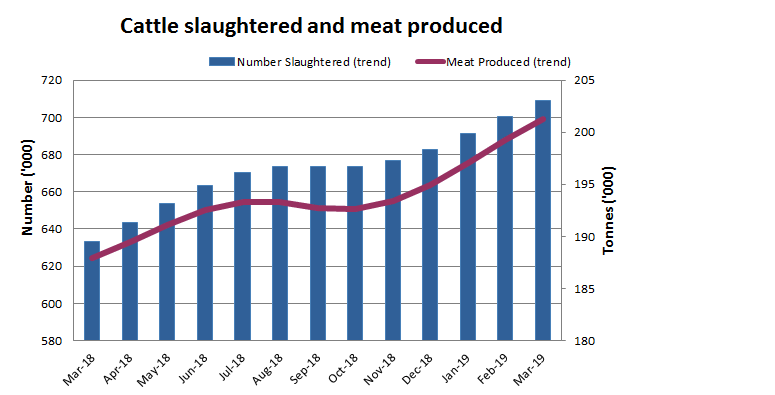AUSTRALIAN beef production in March reached its highest monthly level since 2015, statistics released by the Australian Bureau of Statistics this morning show.
The prolonged and lingering impact of drought across eastern Australia continues to be reflected in unusually high rates of kill, especially for cows.
Adult cattle slaughtered across Australia during March increased 1.2pc on the month before, to 708,900 head, and were 12pc higher than the corresponding March kill a year earlier, ABS data shows.
Overall beef production volume paralleled that trend, being up 1pc on February to 201,300t, and up 7.1pc on the March period last year. The percentage discrepancy between cattle slaughtered, March-to-March, and beef tonnage produced, can be partly explained by lighter carcase weights as the drought has intensified this year.

The ABS graph published here is a 12-month rolling average*, which is seasonally-adjusted. Nevertheless it clearly shows the rise in processing activity that has occurred over the past 12 months under drought pressure. It also captures the sense of disquiet that is emerging in processing circles about slaughter cattle supply prospects in the back half of this year, which look bleak, at best.
While the ABS data contains a considerable lag factor due to data collection, April slaughter rates have also remained well above year-on-year rates, when differences in public holidays are taken into account.
Grid prices steady
Direct consignment grid offers from processors in Queensland remain unchanged again this week. Quotes seen this morning have offers for slaughter in southern and central Queensland in coming weeks at 535-540c/kg for four-tooth grassfed ox and heavy cows at 435-440c/kg.
Reports vary somewhat about the number of cattle coming to market.
One large processor suggested his company’s Queensland plants were now carrying heavy bookings for the next three to four weeks – an inflow of supply the size of which had come as a surprise.
Big intakes of cows from dry eastern parts of the Northern Territory was one factor in supply congestion, he suggested, but so to was the arrival of colder weather which had promoted more tidying up of herd numbers before winter.
Other processors said early May was often a trigger-point greater for cattle supply, and they saw nothing unusual or unexpected in current rates of bookings.
“There’s a few more cattle about, but certainly not above what we would expect heading into May,” one processor contact said. “Cow numbers are still strong, but it is a bit of everything,” he said.
“The Barkly cattle, especially light cows, are beginning to flow a little earlier than some might have expected given the dry conditions up north, but numbers are flowing from across a wide area.”
“But this time of year, it’s not unusual to have a few cattle put in front of us – and with the accumulation of lost working days due to holidays, and cattle held back due to disruptions caused by earlier rain in some areas, I’m not surprised at the current flow of slaughter cattle,” the contact said.
“It’s an accumulation of factors – and certainly not a massive oversupply of numbers.”
Another large multi-site processor’s livestock manager said his company was still a long way shy of getting to a point where it could say it had “plenty of cattle in front of it.”
“We might get to a position where we see some full shift weeks, instead of dropping days because of the available numbers, but I would not support the view that there is an abundance of cattle about,” he said.
Beef kills getting back to normal
Rates of beef kill are still getting back to normal across Eastern Australia after two badly interrupted public holiday weeks in late April.
A Labour Day Holiday observed in Queensland yesterday will have some remaining impact on northern kill reports this week, but after that full working weeks resume for some time.
NLRS reported last week’s Eastern States kill to Friday at 141,522 head, up 62pc on the previous three-day Easter Monday /ANZAC working week. Kills were 2pc lower than the same week last year.
Queensland accounted for 73,372 head last week, down 5pc on this time last year, while the NSW kill reached 33,363 head, much the same year-on-year.
Victoria’s kill last week reached 24,342 head; South Australia’s 5981 head; and Tasmania 4464 head.
* A moving or rolling 12-month average is commonly used with time series data to smooth out short-term fluctuations and highlight longer-term trends or cycles. Essentially, it is a report that uses the running total of the values of the last 12 months of an indicator. Each month, the indicator that is 13 months old is dropped from the total and the new month’s indicator value is added. Why use this approach rather than looking at the actual values? While the actual values are important for many reasons, they do not necessarily show trends that can point to growth, flattening or decline.
